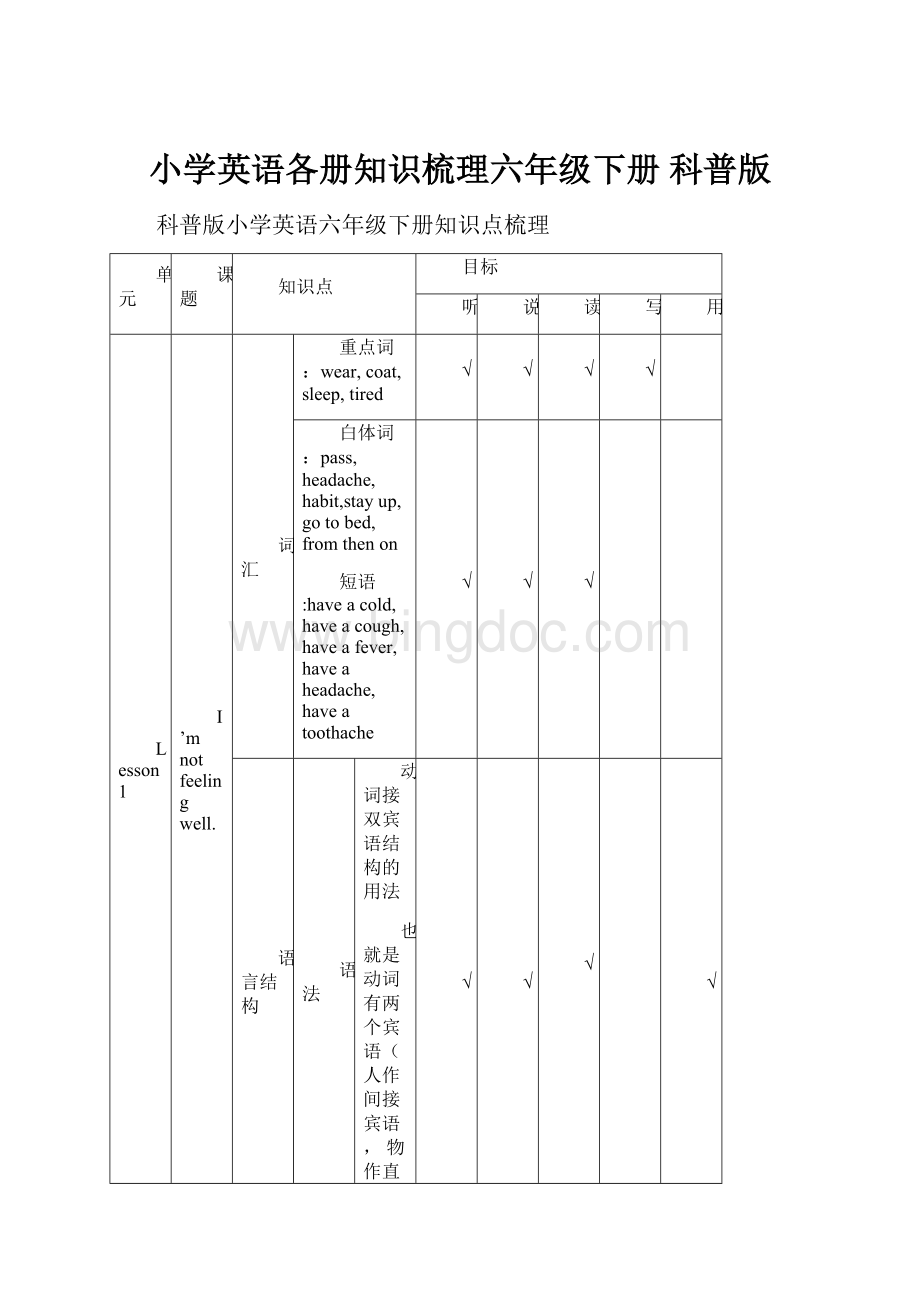小学英语各册知识梳理六年级下册 科普版.docx
《小学英语各册知识梳理六年级下册 科普版.docx》由会员分享,可在线阅读,更多相关《小学英语各册知识梳理六年级下册 科普版.docx(32页珍藏版)》请在冰点文库上搜索。

小学英语各册知识梳理六年级下册科普版
科普版小学英语六年级下册知识点梳理
单元
课题
知识点
目标
听
说
读
写
用
Lesson1
I’mnotfeelingwell.
词汇
重点词:
wear,coat,sleep,tired
√
√
√
√
白体词:
pass,headache,habit,stayup,gotobed,fromthenon
短语:
haveacold,haveacough,haveafever,haveaheadache,haveatoothache
√
√
√
语言结构
语法
动词接双宾语结构的用法
也就是动词有两个宾语(人作间接宾语,物作直接宾语)。
如:
givemeapen(me是间接宾语,apen是直接宾语)。
常用的能接双宾语的及物动词有:
give,teach,buy,lend,hand,leave,sell,show,read,pay,make,pass,bring等。
注意当间接宾语为人称代词时,一定要用其宾格形式。
√
√
√
√
句型
I’mnotfeelingwell.What’sthematter?
Ihaveacold.Couldyougivemesomewater,please?
OK.
交际用语
What’sthematter?
I’mnotfeelingwell.
Couldyougivemesomewater,please?
Hereyouare.
√
√
√
Lesson2
Didyouplaybasketballyesterday?
词汇
重点词:
visit,photo,angry,high
√
√
√
√
白体词:
once,trip,build,takephotos
动词短语:
playbasketball,washmyclothes,watchTV,
worklate
过去时间:
yesterdayafternoon,yesterdaymorning,
yesterdayevening,lastnight
√
√
√
语言结构
语法
含实义动词的一般过去时态
在一般过去时态中,实义动词要用其过去式形式。
实义动词的过去式有规则变化和不规则变化两种,本课主要学习规则动词的变化。
变化规则如下:
1)一般情况下,在动词原形后直接加-ed。
如:
wanted,played。
2)以不发音的字母e结尾的动词,直接加-d。
如:
hoped,lived。
3)重读闭音节单词需双写最后一个辅音字母,再加-ed。
如:
stopped,shipped。
4)以辅音字母+y结尾的动词变y为i,再加-ed。
如:
studied,worried。
一般过去时态没有人称和数的变化,其否定句和疑问句要借助助动词did。
不管主语的人称和数是什么,均用did。
其肯否问答特句型变换如下:
肯定句:
I/He/She/We/Theyplayedfootballyesterday.
否定句:
I/He/She/We/Theydidn’tplayfootballyesterday.
一般疑问句:
Didyou/he/she/you/theyplayfootballyesterday?
肯定回答:
Yes,I/he/she/we/theydid.
否定回答:
No,I/he/she/we/theydidn’t.
特殊疑问句:
Whatdidyou/he/she/you/theydoyesterday?
√
√
√
√
句型
Didyouplaybasketballyesterday?
Yes,Iplayedbasketballyesterdayafternoon.
交际用语
Didyouhaveagoodtime?
It’syourgardennow,littlechildren.
√
√
√
Lesson3
DidyougoboatinglastSunday?
词汇
重点词:
boat,zoo
√
√
√
√
白体词:
last,life,protect,mine,middle,off,world
短语:
haveagoodlookat,doone’sbest,waitfor,inthemiddleof,aftersometime
动词短语:
stayathome,gotothezoo,walktoschool,rideabike,drawsomepictures,takesomephotos,readabook,writealetter,buysomefruit,buysomevegetables
√
√
√
语言结构
语法
继续学习一般过去时态的一般疑问句形式及肯定否定回答
√
√
√
√
句型
DidyoustayathomelastSunday?
No,Iwenttothezoo.
交际用语
DidyougoboatinglastSunday?
No,IwenttoTigerZoo.
√
√
√
Lesson4
WhatdidyoudolastSaturday?
词汇
重点词:
supermarket,taxi,sweater,cool,young,clothes
√
√
√
√
白体词:
poor,dead,quickly,lose
短语:
tryon,puton
动词短语:
seeafilm,makeacake,flyakite,domyhomework
√
√
√
语言结构
语法
一般过去时态的特殊疑问句
√
√
√[来源:
]
√
句型
WhatdidyoudolastSaturday?
Isawafilm.
交际用语
Whotookyouthere?
Howdidyougothere?
Myuncleboughtmearedsweater.
Itlooksniceonyou.
√
√
√
Lesson5
Revision
词汇
重点词:
umbrella
√
√
√
√
白体词:
luck
√
√
√
语言结构
语法
1.复习动词接双宾语结构
2.复习一般过去时态
√
√
√
√
句型
复习前4个单元的主题句:
I’mnotfeelingwell.What’sthematter?
Ihaveacold.Couldyougivemesomewater,please?
OK.
Didyouplaybasketballyesterday?
Yes,Iplayedbasketballyesterdayafternoon.
DidyoustayathomelastSunday?
No,Iwenttothezoo.
WhatdidyoudolastSaturday?
Isawafilm.
交际用语
Ifeelbad.
Don’tworryaboutyourlessons.
Becauseitrainedsuddenlyandwedidn’thaveumbrellas.
Weallgotwet.
Whatbadluck!
Lesson6
Istherealibrarynearhere?
词汇
重点词:
library,left
√
√
√
√
白体词:
end,surprised
短语:
attheend,ontheright,nextto,lookfor
地点类:
busstation,hospital,bookshop,school,park,supermarket
√
√
√
语言结构
语法
复习therebe句型及问路的表达
√
√
√
√
句型
Istherealibrarynearhere?
Yes,thereis.
HowcanIgetthere?
...
交际用语
Istherealibrarynearhere?
HowcanIgetthere?
Godownthisstreet.
Turnleftattheend.
Youcanseeitontheright.
√
√
√
Lesson7
Wheredothetigerscomefrom?
词汇
白体词:
lovely
短语:
alotof
√
√
√
语言结构
语法
复习一般现在时态和现在进行时态的用法
(1)一般现在时态表示经常性、习惯性的动作或状态,常常与频度状语连用。
在一般现在时态句子中动词be在人称和数上应与主语保持一致,选用am,is,are。
其他动词若主语是第三人称单数,则应按动词第三人称单数的变化规则进行相应变化。
动词第三人称单数的变化规则:
1)一般情况下,在动词后直接加-s,如works,gets,reads等。
2)以s,x,ch,sh或o结尾的动词,在动词后加-es,如goes,teaches,washes等。
3)以辅音字母加y结尾的动词,把y变为i,再加-es,如study—studies,try—tries,carry—carries等。
4)动词have在遇主语是第三人称单数时,要将have改为has,如Hehasaninterestingbook.
(2)现在进行时态表示说话时正在进行且尚未完成的动作或状态,常与now,atpresent等时间状语连用。
其结构是“助动词be+现在分词”,其中的be可以随主语人称不同而用am,is,are。
现在分词的三种构成规则:
1)一般情况下直接加-ing,如:
play-playing,carry-carrying
2)以不发音的字母e结尾的单词,去掉e,再加-ing,如:
ride-riding,come-coming
3)以重读闭音节结尾、呈现“辅—元—辅”结构的单词,先双写末尾的辅音字母,再加-ing,如:
swim-swimming,sit-sitting
√
√
√
√
交际用语
Look!
Theretheyare.
They’remyfavouriteanimals.
Let’stakesomephotosofthem.
√
√
√
Lesson8
Whoareyougoingtoplay?
词汇
重点词:
between,hour
√
√
√
√
白体词:
team,later,cloud,clear,shine,raincoat
短语:
talkabout,laughat
√
√
√
语言结构
语法
复习一般将来时态
一般将来时表示将来某个时间要发生的动作或存在的状态,常与表示将来的时间状语连用,如:
tomorrow,nextweek,nextyear等。
一般将来时主要有两种结构:
1)助动词will/shall+动词原形
其肯否问答特变换形式如下:
陈述句:
I/He/She/We/Theywillswimtomorrow.
否定句:
I/He/She/We/Theywillnotswimtomorrow.
一般疑问句:
Willyou/he/she/you/theyswimtomorrow?
肯定回答:
Yes,I/he/she/we/theywill.
否定回答:
No,I/he/she/we/theywon’t.
特殊疑问句:
Whatwillyou/he/she/you/theydotomorrow?
2)begoingto+动词原形
其肯否问答特变换形式如下:
陈述句:
Iamgoingtoswimtomorrow.
否定句:
Iamnotgoingtoswimtomorrow.
一般疑问句:
Areyougoingtoswimtomorrow?
肯定回答:
Yes,Iam.
否定回答:
No,I’mnot.
特殊疑问句:
Whatareyougoingtodotomorrow?
√
√
√
√
交际用语
There’sgoingtobeafootballmatchbetweenJapanandChina.
I’dloveto,butIcan’t.Whatapity!
Goodlucktoyouandyourteam!
√
√
√
Lesson9
Ihelpedadeafmantogethome.
词汇
重点词:
√
√
√
√
白体词:
deaf,queen
√
√
√
语言结构
语法
复习一般过去时态
一般过去时态表示过去发生的动作或过去存在的状态,动词要用过去式。
动词be的一般过去时态:
动词be在一般过去时态中只有was和were两种形式,was用在单数主语(I,he,she,it等)后,were用于复数主语(you,we,they等和单数主语you)后。
实义动词的一般过去时态:
在一般过去时态中,实义动词要用其过去式形式。
实义动词的过去式规则变化:
1)一般情况下,在动词原形后直接加-ed。
如:
wanted,played。
2)以不发音的字母e结尾的动词,直接加-d。
如:
hoped,lived。
3)重读闭音节单词需双写最后一个辅音字母,再加-ed。
如:
stopped,shipped。
4)以辅音字母+y结尾的动词变y为i,再加-ed。
如:
studied,worried。
√
√
√
√
交际用语
Whyareyousolatetoday,Peter?
Youdidagoodjob,Peter.
Ireallydidn’tknowhowtotalktohim.IthinkIshouldlearnsomesignlanguage,sothatIcanhelpmorepeople.
√
√
√
Lesson10
Revision
词汇
重点词:
holiday,student,parent,travel,moon
√
√
√
√
白体词:
ago,famous,capital,climb
√
√
√
语言结构
语法
综合复习
√
√
√
√
句型
复习本册所学句型
交际用语
You’llloveit!
Howlongdidittakeyoutogetthere?
Ittookaboutthreehourstogettherebyplane.
IhopetogotoHongKongsoon.
√
√
√